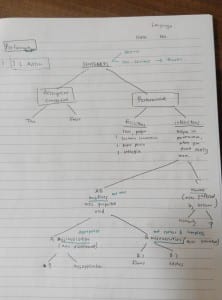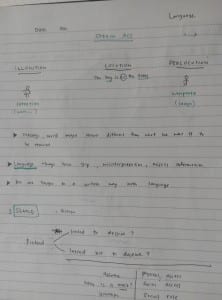What is performativity and how have the performing arts appropriated the word wrongly?
What is the difference between constative and performative?
How did Derrida take the concept of performativity back to Platonic principle of the idea and what is his contribution?
How can the performative explain our societal role and what are those processes that make an action performative?
How can the speech act theory help us understand our relationship with our audience ?
PERFORMATIVITY
Signature Event Context (Jacques Derrida)
In the first paragraph, author discuss about the word Communication. This word does not limit itself to semantics, semiotic and linguistic, where it does not only possess one meaning.
In my point of view, this is one way of communication without speaking or writing.
This is the story telling part of Pushpanjali dance (Bharata Natyam). A way of using abhinaya(facial expression) and hand gestures to communicate with audience. But in order to understand it, you need contextual informations.
There is a point saying that ambiguous (indefinite) of the word ‘communication’ can be reduce by the limits of what it called a ‘context’.
Another important point from the text is that compass of voice/of gesture would face factual limit, an empirical经验 boundary of space and of time; while writing, at the same time and same place, would able to relax those limits & open wider scope on the same field. The meaning of semantics message will then be transmitted and communicated by different means in more powerful way. Thus the wholeness of meaning will not affected.
Why a context is never be completely determinable? This structural uncertain would have double effects:
1. it would mark the theoretical inadequacy不足之处 of the current concept of context
2. it would necessitate a certain displacement & generalisation of the concept of writing.
I am interested with Analogy打个比方:
-A comparison between one thing and another, typically for the purpose of explanation or clarification.
– some analogies can be understand by the people who speak the same language or same region & country. Some small group of people usually has their own analogies which only they understand them.
Performativity by James Loxley
Showing performative in language.
J.L.Austin defined two views of language:
1. Logical Positivism – that the normal or defining business of language is making statements, and that statements are to be assessed in terms of their truth.
2. The Descriptive Fallacy – the mistaken assumption that language use is essentially constative, aimed at the production of true or false statements/descriptions.
An important point: To say, in this instances, is to do: Austin christens this kind of sentence or utterance(statement,spoken word)话语 performative, to make clear that here ‘the issuing of the utterance is the performing of an action.
Austin explained that there are rules in order to have successful performative and he stated 6 conditions:
1. existence of an accepted conventional procedure that include the utterance of certain words by certain person in certain circumstances and having the conventional effect.
2. the person and circumstances in a given case must be appropriate.
3. procedure must be executed by all participant both correctly and
4. completely
5. the procedure designes for use by persons having certain thoughts and feelings, then the participants invoking the procedure must have those thoughts and feelings, participants must intend so to conduct themselves, further
6. must conduct themselves subsequently.
Then a performative can consider success or felicitous恰当.
But does it have to be so formulated or structured?
There are also example of penalty awarded even though no foul in a football match. In this circumstances, the performance is not consider void无效. It is returning such utterance话语 to constative(denoting a speech act or sentence that is a statement declaring something to be the case).
Non-serious Performative
When the language use in a non-serious way such as in a performance, drama or poem, the performative utterance will become void. Non-serious utterance is also understood as imitation of a seriousness, called as ontological(specification of how to represent the objects, concepts and other entities that are assumed to exist in some area of interest and the relationships that hold among them) realness.
Index
- semantics – the study of meaning, the study of linguistic development
- analogy – http://examples.yourdictionary.com/analogy-ex.html
- speech act – is an utterance that has performative function in language and communication.
Being Performative (Butler)
In the subtopic Rethinking the body, Challenging Identity: The Demands of Politics, Judith Butler questioned around how identity is being shape and constructed and asking if is the body is shaped by political forces to keep the body bounded and follow the markers of sex.
The normative way of thinking about man and woman is always in a binary fashion and there are 3 levels:
1. sex/sexed body – female and male
2. the level of social and cultural identity of gender, which their characteristic divided properly into feminine and masculine.
3. level of sexuality and desire, which is men desiring women and women desiring men.
Feminism, Sex and Gender
Binary division is Hierarchical, where men and masculine are the primary and central, where the opposite sex is the marginal. Feminism or feminists try to challenge this framework.
- gender is the cultural constructions of sex.
Butler’s strategy is to try articulating the interflow of multiple sexual discourses at the site of identity in order to render the category, permanently problematic. The difficulty of categorise intersex and transsexual people, and explore the significance for a politics of sexuality of cross dressing and gender differentiations.
Performativity and The Construction of Identity
What important here is that implications drawn from Butler’s diagnosis of trouble of gender , and conceptual resources that make good that diagnosis.
Butler rejected mirror-image phenomena, where characterizing body as passive, and culture as active. What is required is an account of this terrain that able to get past the gender polarity(difference) of natural bodies and culture meanings, one who is able to rethink the complex relation between corporeality and identity.
Identity, culture is the process of creating identity, here is where the difference between body and self is produced.
Concept of Performativity:
The identity we describe through the term gender is constituted组成 through the performance of a set of Acts that forge伪造 us as gendered subjects.
Butler mentioned that gender is prior to the various act, posture and gesture that conform根据 expected gender identity and this is performative = gender reality.
Our gendered acts.
The effect of gender is produced by the stylisation of body, bodily gesture, movements and style creates an illusion of an abiding gendered self.
When this repeatable acts and repetition of recognised style is being put in the public, it is conventional. This is not identity but is gender identity in being performed.
The Power of Gender Norms
In this topic, author used the theories from different philosophers such as J.L.Austin, Judith Butler and even Michel Foucault and discussed around this topic.
The conventional of speech situation is part of the necessary conditions of the shared world. For Austin, it is seemingly enough to call philosophy back to recognising everyday communal dimension of linguistic life. Butler thinks the norms of gender is radically different presupposition. The performative norm is a form of compulsion, and the composition of body itself an exercise in confining it within a limit.
It is important to understand the force and power that characterise the social relations among speaking body. Butler’s main influence was Michel Foucault. Foucault thinks that force stops the possibilities and energies arising from other source. He also analysed a productive and positive mode of power. He mentioned that power is not a singular thing, it conceive relation of force and works on active object. Our identities are not necessary single or simple however it has been formulated and practiced. For example, the classification of homosexual in mid 90s not just got complaints, it become resources for a demand for political and legal recognition, it also continue challenge the way of thinking about nature sexuality.
Feminist – explanation of sex & sexuality which assume the meaning of human’s social existence can be derived from faces of physiology.
The body is ‘an historical idea’ rather than ‘a natural species’ by Merleau-Ponty.
Body is understand to be an active process of embodying, reflecting cultural & historical possibilities. Body is an historical idea – it gains meaning through a concrete & historically mediated expression in the world.
Beauvoir – body is a historical situation, and is a manner of doing, dramatising, reproducing a historical situation.
Gender as an act, as a corporeal style: is intentional & performative(dramatic & non-referential).
Woman (gender) – as the cultural interpretation/signification of biological fact.
To be a woman:
- become cultural sign
- to materialize oneself follow historically delimited possibilities.
- repeat corporeal project.
those who fail, regularly punished.
Read also:
http://feministtheorykeywords.wordpress.com/2007/11/20/thoughts-on-judith-butler/
INDEX:
Binary – relating, composing, involving 2 things.
Feminism -the advocacy of women’s rights on the ground of the equality of the sexes.
Feminist theory – to understand the way of systemic political & cultural structure are enacted & reproduced, through acts & practices, and how analysis of ostensibly表面上 personal situations is clarified through situating the issue in shared cultural context.
Gendered body – acts its part in a critically restricted corporeal space & enacts interpretations within the confines of already existing directives.
J.L.Austin – was a British philosopher of language. He is remembered primarily as the developer of the theory of speech acts.
Judith Butler -is an American continental philosopher and gender theorist whose work has influenced political philosophy, ethics and the fields of feminist, queer and literary theory.
Jacque Derrida -a French philosopher, born in French Algeria. Derrida is best known for developing a form of semiotic analysis known as deconstruction. He is one of the major figures associated with post-structuralism and postmodern philosophy.
Biopolitics-An Advanced Introduction by Thomas Lemke
what is biopolitics?
Biopolitics is an intersectional field between biology and politics. The term is commonly attributed to Rudolf Kjellén in the 1920s who also coined the term geopolitics; however, it appears in print at least as early as 1912.
Biopolitics
The term is used to discuss political asylum policies, as well as the prevention of AIDS and questions of demographic change. Biopolitics may refer to issues as diverse as financial support for agricultural products, promotion of medical research, legal regulations on abortion, and advance directives of patients specifying their preferences concerning life-prolonging measures.
Biopolitics
From this point of view, “biopolitics” has to be considered an oxymoron, a combination of two contradictory terms. The advocates of this position claim that politics in the classical sense is about common action and decision- making and is exactly what transcends the necessities of bodily ex- perience and biological facts and opens up the realm of freedom and human interaction.
Sovereign主权 Power & Bare Life: Giorgio Agamben
‘Bare life’ – considered as marginal and seems to be furthest from political, proves to be the solid basis of a political body, which makes the life & death of human being the object of a sovereign decision. For example, in asylum seekers, refugees, and the brain dead. These apparently unrelated “cases” have one thing in common: although they all involve human life, they are excluded from the protection of the law.
[In Homo Sacer, Agamben aims to connect the problem of pure possibility, potentiality, and power with the problem of political and social ethics in a context where the latter has lost its previous religious, metaphysical, and cultural grounding. Taking his cue from Foucault’s fragmentary analysis of biopolitics, Agamben probes the covert or implicit presence of an idea of biopolitics in the history of traditional political theory. He argues that from the earliest treatises of political theory, notably in Aristotle’s notion of man as a political animal, and throughout the history of Western thinking about sovereignty (whether of the king or the state), a notion of sovereignty as power over “life” is implicit隐.
The reason it remains merely implicit has to do with the way the sacred, or the idea of sacrality, becomes indissociable from the idea of sovereignty. Drawing upon Carl Schmitt’s idea of the sovereign’s status as the exception to the rules he safeguards, and on anthropological research that reveals the close interlinking of the sacred and the taboo, Agamben defines the sacred person as one who can be killed and yet not sacrificed—a paradox he sees as operative in the status of the modern individual living in a system that exerts control over the collective “naked life” of all individuals.]
Capitalism and the Living Multitude: Michael Hardt and Antonin Negri
For Hardt (theorist) and Negri(philosopher), biopolitics stand for a new stage of capitalism资本主义 characterised by the disappearance of the borders between economics and politics, production and reproduction. As many activists search for theoretical instrument to analyse international politic and reconstructing of modern capitalism. They both see the economic dimension of Empire as a new stage of global capitalist production in which all states and regions of the world are integrated and connected. This foundation does not refer to the configuration of the global market but also to a previously unreached depth of capitalist socialisation. This included the constitution of manpower, production of bodies, intellects and affects.
‘Cognitive Capitalism’ slowly take over. It is distinguished by an informatized, automated, networked, and globalised production process then lead to a decisive transformation in the working subject. (knowledge and creativity, language and emotion, are central to production & reproduction within society)
This process created ‘ immaterial labor’:
1. involved in informationalized and incorporated communication technologies industrial production.
2. the immaterial labor of analytical and symbolic tasks.
3. involves the production and manipulation of affects and requires human contact, labor in the bodily mode.
‘Human rights through a Biopolitical lens?’
economic exploitation: that is, the act of using another person as a means to one’s profit, particularly using their labor without offering or providing them fair retribution. Marxist theory points to the entire capitalist class as an exploitative entity, and to capitalism as a system based on exploitation.






Comments are closed.